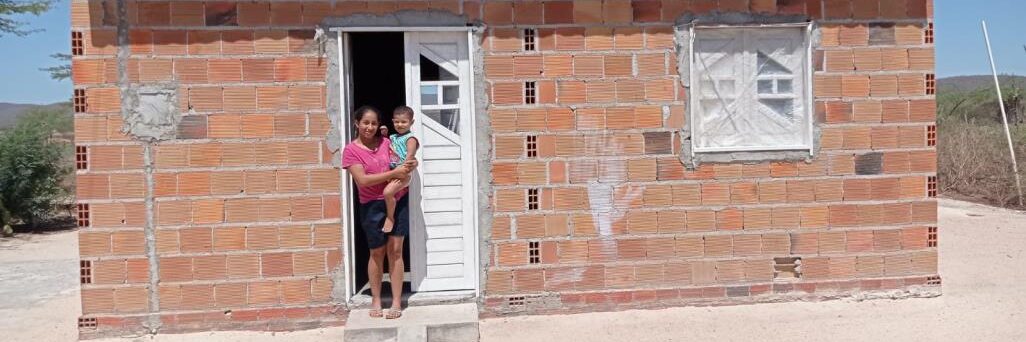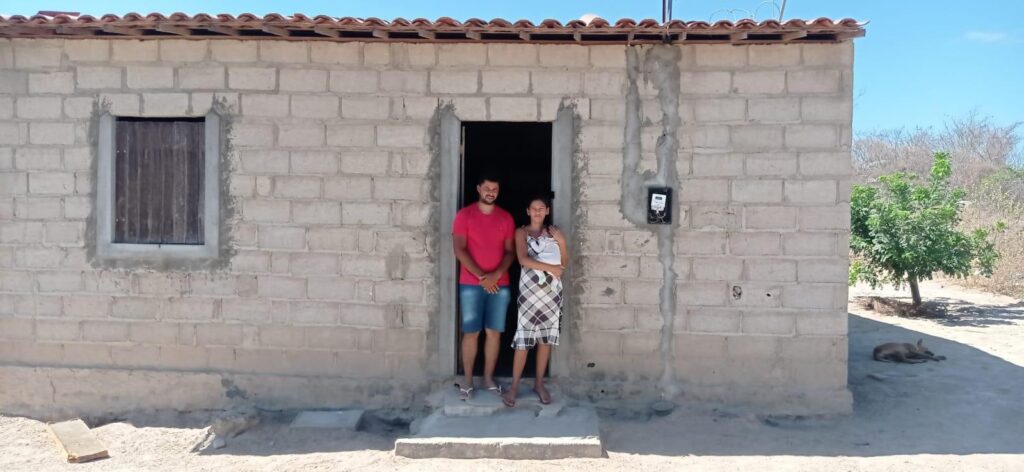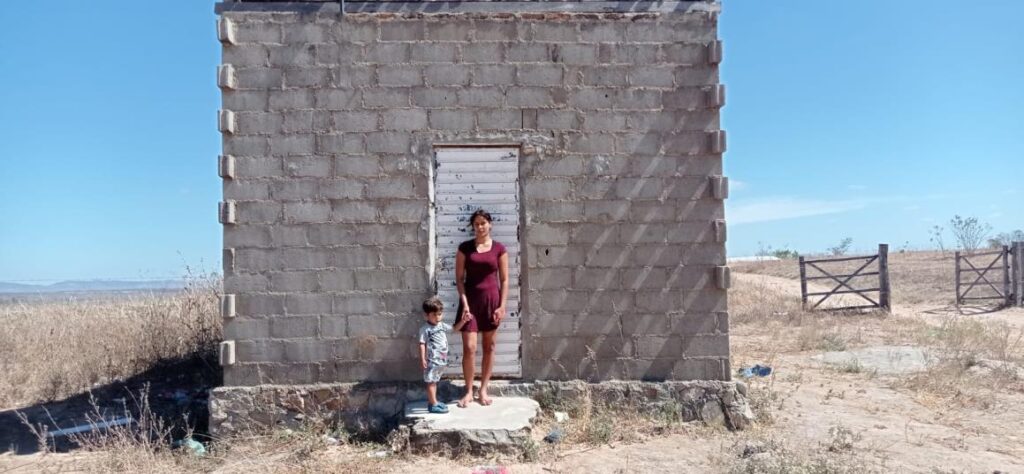Canapi, Alagoas, Brasil, Brasil
In collaboration with

November 2023 – April 2024
Provide drinking water to rural families through a rainwater collection system in cisterns. Generate a change in behaviour regarding the conscious use of water.
Objectives
- Contribute to safe access to drinking water, reduce the spread of waterborne diseases and increase food security.
- Guarantee access to water in periods of drought.
Beneficiaries
150 direct
75 women and 35 children under 15.
2,350 indirect
1,175 women and 300 children under 15.

On the ground
There is a lack of water supply, especially in the dry season, and high vulnerability to climate change, with the proliferation of waterborne diseases that have a very negative impact on child malnutrition.
The Semi-Arid Region of Brazil is one of the areas suffering the most from climate change crises. There has been an increase in the frequency and intensity of extreme phenomena and changes in precipitation and temperature patterns, with a tendency towards drought and heat waves.
The Sertão is a subregion of the Semi-Arid Region in northeastern Brazil that is located within the so-called “polygon of drought”, a term that the Brazilian Government used to identify the areas most affected by water scarcity and aridity for the purpose of implementing specific development policies and programs. The rainy season typically occurs between December and March. During this period, intense and torrential rains can occur, although their duration and quantity vary significantly from one year to the next. These rains are vital for the region, as they are crucial for the life cycle of flora and fauna, as well as for local agriculture.
The Sertão is preferably inhabited by rural communities of farmers and ranchers who are the basis of the local economy. The Sertão covers several northeastern states, such as Ceará, Piauí, Paraíba, Rio Grande do Norte, Alagoas, Sergipe and parts of other states such as Bahía and Maranhão.
The municipality of Canapi, where the project is located, is in the interior of the state of Alagoas, 254 kilometers from its capital, Maceió. The municipality is inhabited by a predominantly rural population with low levels of education and income. Furthermore, poverty and social inequality are endemic problems that hinder development in the region, which are often neglected by federal, state, and local governments and cause a severe lack of water supply infrastructure, sanitation services and primary education.
Currently, only 12,217 inhabitants, 31.04% of the population of Canapi, have access to drinking water, which is why they are in a highly vulnerable situation. The lack of water harms human consumption and the region’s agriculture. In addition to the small amount of water available, the lack of purification encourages the proliferation of waterborne diseases that have a very negative impact on child malnutrition.
Climate change is having serious socioeconomic repercussions in the region, which has suffered a notable reduction in agricultural productivity and soil impoverishment due to desertification and erosion. The vulnerability of rural communities has increased, affecting food security and increasing the geographical imbalance in the country as a whole.
In Canapi, it is necessary to provide drinking water to the most vulnerable families and generate a change in behaviour regarding the conscious use of water. This will indirectly benefit the entire rural community, as it will increase the volume of accessible drinking water, reducing water rationing and, consequently, poverty. We estimate that 30 cisterns with a storage capacity of 16,000 litres will be necessary.
The construction of cisterns has a significant positive impact on the beneficiary population. In terms of socioeconomic development, cisterns allow families to store rainwater for human consumption, reducing the need to buy water from cistern trucks or travel long distances to fetch water from public sources. This frees up financial resources that can be invested in other areas, such as education, health and agricultural production. Additionally, cisterns can be used to irrigate small gardens and orchards, which can increase food production and generate income for families.
In terms of gender equality, obtaining water is a task that has historically fallen to women. The cisterns allow women to save time and effort that they could invest in other activities. Regarding health, cisterns reduce the risk of waterborne diseases such as diarrhoea, cholera and typhoid.
Lastly, they help preserve the environment. Rainwater is collected and stored sustainably, preventing waste and water pollution. The construction of cisterns, together with education and awareness actions about the importance of water and the sustainable use of water resources, can generate benefits such as increased school attendance of children and adolescents, who no longer have to miss school to go get water; improve the quality of life of women, who have more time to dedicate to other activities; reduce infant mortality due to lower risk of waterborne diseases; increase agricultural production, generate income, and provide employment opportunities.

In detail
In the implementation of this project, we worked in partnership with Cactus, a local civil society organization that has actively participated in the design of the proposal and that, by being in the field, provides relevant information on local needs and proposes appropriate solutions. It also collects information and prepares reports on the progress of the project development, which are then analyzed and reviewed by World Vision. The community’s knowledge of both entities has established a link that facilitates active participation in the design of the supply network and the construction process of the cisterns.
In this way, the identification of the most vulnerable families and the resolution of problems are carried out with a deep knowledge of the community. Furthermore, this prior relationship of trust facilitates training and the exchange of information, which allows the community to guarantee the sustainability of the facilities.
The project’s basis is to ensure that the 16,000 liters of the cisterns allow families to have access to drinking water beyond the rainy season (from December to March), during periods of drought that, as they increase, subject the community to water stress and scarcity.
The first step is mapping the locations for the construction of the cisterns. For this purpose, data related to families’ water needs are collected and analyzed, taking into account the previously defined vulnerability criteria. Access to water resources and the availability of construction materials are also evaluated. This activity involves the entire community and thus creates an initial knowledge base.
Based on the information collected, the hydraulic design of the cisterns will be prepared. This design must take into account the required storage capacity, the area available for its construction, the rainwater collection system, and the distribution method.
Next, we proceed to prepare the locations. This task includes clearing the area and levelling the ground.
The second step is the construction of the cisterns, which is carried out with the direct support of the beneficiary families. These infrastructures are designed as tanks to store rainwater and are built with precast cement slabs. They are cylindrical or rounded and are covered to prevent contamination and evaporation of the stored water. They are half-buried underground, approximately two-thirds of their height, which guarantees the safety of their structure.
The rainwater collection system uses the roofs of the houses to collect water, which is then conducted through zinc or PVC gutters to the cistern storage tank, which has filters attached to guarantee its drinkability. This involves the direct participation of families in placing the gutters on the roofs, the downspouts to the ground, and their connection to the pipes and filters before the water is stored in the cistern.
The next phase is to guarantee the conservation of the systems and the use of rainwater, which depends on the daily care of the facilities, especially during the dry season when problems should not arise. Therefore, it is necessary to continually repair and clean components such as gutters, filters, pumps and tanks.
In this sense, it is essential to incorporate a training plan for the beneficiaries into the project to ensure the proper functioning of the facilities and plan maintenance actions. Therefore, the project includes activities with the local community to practice simple management actions, such as inspecting components, cleaning them, and detecting common failures and problems. These actions reduce long-term risks and increase useful life. The frequency of planned maintenance can be modified if insufficient, thus ensuring proper system maintenance.
In addition to technical training on the facilities, it is essential to provide the community with knowledge about the conscious and correct water use.

Prospects for sustainability
Cistern construction, operation, and maintenance are relatively simple and economical. They are facilities aligned with the values and cultural practices of the rural communities of the Sertão. Rainwater is considered a very important resource, and the construction of cisterns is considered a way to preserve this resource.
Local communities’ participation in the construction and maintenance of the cisterns is essential to the program’s success. It helps ensure that they are built according to the needs and expectations of beneficiary families. This technology is also ubiquitous and proven in other projects we developed with World Vision. Cactus, the local partner, also has extensive experience in implementing and operating these facilities.
Training the beneficiaries in operating and maintaining the cisterns will guarantee the future operation of the installed water storage systems. In addition, the beneficiaries will carry out part of the construction and installation work as a form of knowledge transfer and active local participation in the activities. Finally, the Cactus organization will continue to work locally to keep systems running after the project is completed.

